A well-designed balcony garden can bring nature right to your door. It turns a busy city spot into a peaceful oasis. Even with a small area, you can enjoy the outdoors.
Setting up a balcony garden is simpler than you might think. You need to plan well, thinking about space and sunlight. With the right plants and tools, your small garden can flourish. This makes your outdoor space more beautiful and useful, no matter the size of your balcony.
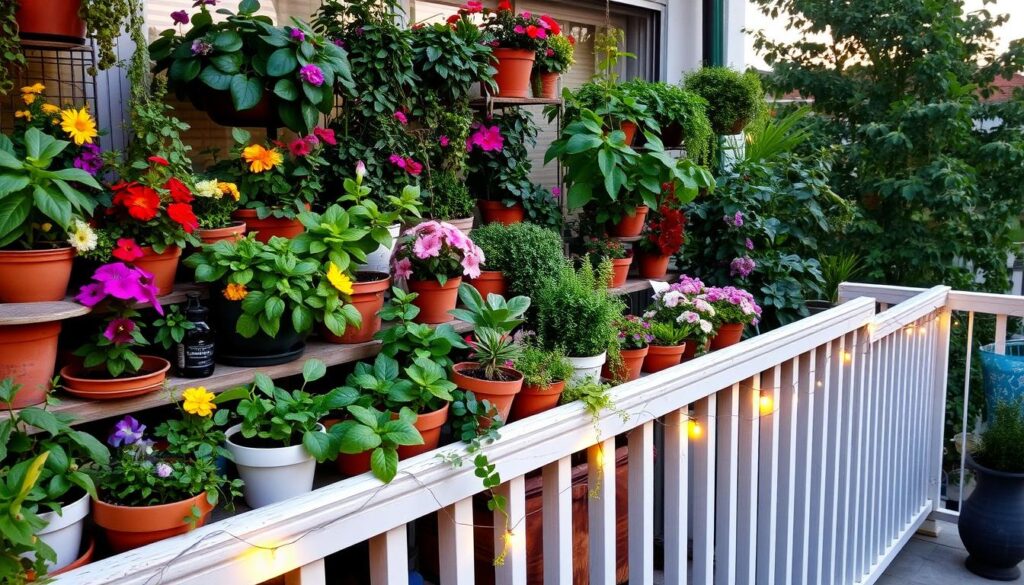
A balcony garden is more than just a pretty view. It brings calm and well-being to your space. By adding a small garden, you can make a peaceful area to relax. With smart design, your balcony garden can be a perfect urban retreat.
Key Takeaways
- Transform your outdoor space into a peaceful oasis with a balcony garden
- Create a small garden even in a limited area
- Choose the right plants and equipment for your balcony garden
- Consider your available space and sunlight when planning your garden
- A balcony garden can provide a sense of calm and well-being
- Incorporate a small garden into your outdoor space to create a serene retreat
Getting Started With Your Balcony Garden
Urban gardening is all about the details, from design to plant selection. Assess your balcony’s space and sunlight first. Knowing how much sun it gets and its direction helps pick the right plants.
It’s also key to understand weight limits in container gardening. Heavy pots and soil can be dangerous. Opt for light containers and soil made for balcony gardens. This keeps your garden safe and looking good.
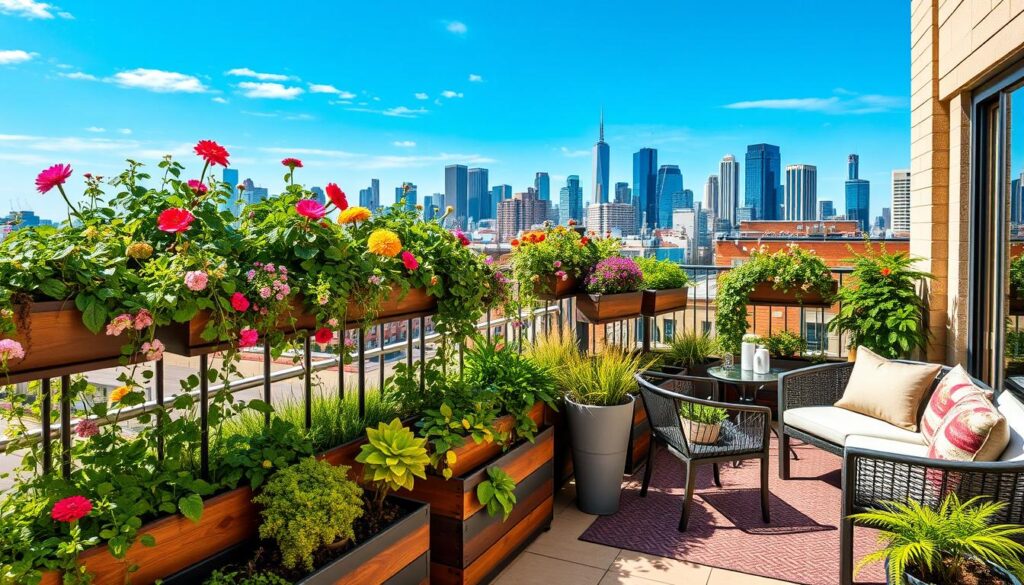
Basic Equipment Needed
To start your balcony garden, you’ll need a watering can, gloves, and a trowel. A self-watering system can also be helpful. Choose your equipment with your garden design in mind. The right tools make your balcony garden beautiful and easy to care for.
Essential Design Principles for Small Spaces
Creating a beautiful small garden or balcony design is key. Scale, proportion, and texture are vital. A well-designed space can be a peaceful oasis in the city. The right decor makes it inviting.
In small spaces, every detail matters. Layering is crucial for depth and interest. Use vertical elements like trellises to add height. Mix textures like stone, wood, and foliage for visual appeal.
Here are some tips for a stunning small garden:
- Use vertical elements to add height and create a sense of layering
- Incorporate a variety of textures to add depth and visual interest
- Choose outdoor decor that complements your balcony design and enhances the ambiance of your small garden

Follow these principles for a beautiful, functional small garden. It can reflect your style and improve your outdoor living. Even a small balcony or patio can become a lovely oasis with the right planning.
Choosing the Right Plants for Your Balcony Garden
Creating a thriving balcony garden starts with picking the right plants. There are many balcony plants to choose from. Think about sunlight, climate, and space when picking. For city gardeners, container plants are great because they’re easy to move.
Here are some plants to consider:
- Sun-loving plants: perfect for balconies with plenty of direct sunlight
- Shade-tolerant options: ideal for balconies with limited sunlight or partial shade
- Seasonal selections: choose plants that thrive in your local climate and season
- Edible plants: great for small spaces, allowing you to grow your own herbs and vegetables
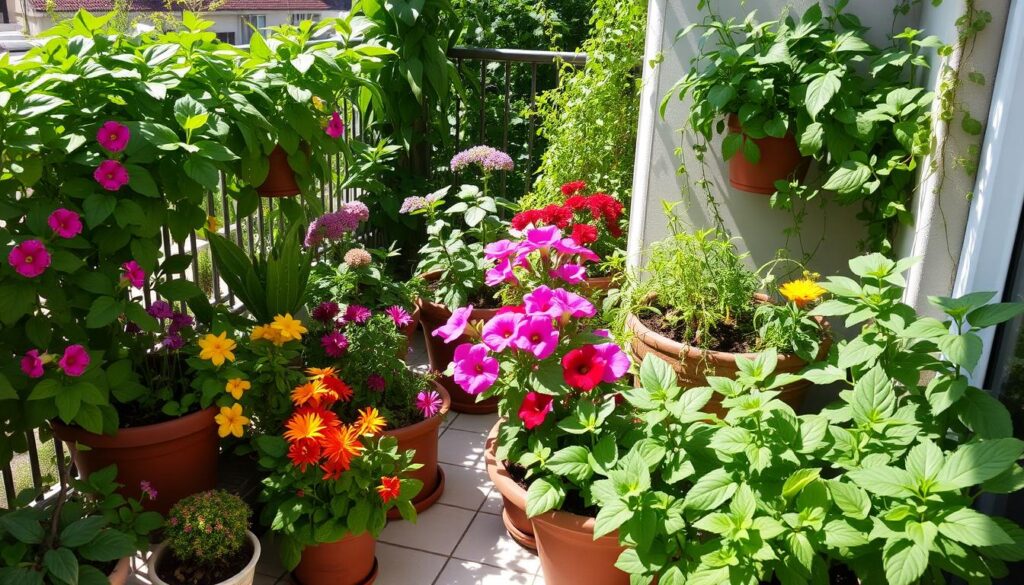
By picking the right plants, you’ll create a beautiful balcony garden. Make sure to meet each plant’s needs. This includes watering, fertilizing, and pruning. This way, your urban gardening setup will flourish.
| Plant Type | Sunlight Requirements | Watering Needs |
|---|---|---|
| Sun-loving plants | Full sun (6+ hours) | Regular watering |
| Shade-tolerant options | Partial shade (4-6 hours) | Infrequent watering |
| Seasonal selections | Varying sunlight | Varying watering needs |
Creative Container Solutions
Container gardening turns your balcony into a lush oasis. It uses space-saving planters to create a unique space. You can move plants around to try out different layouts.
Vertical gardening systems are great for small balconies. They let you grow many plants in a small area. You can use trellises, arbors, or wall-mounted planters.
Vertical Gardening Systems
Vertical gardening is perfect for small spaces. It lets you grow many plants, like vines and leafy greens. Choose a system that fits your needs and the plants you want.
Hanging Baskets and Rails
Hanging baskets and rails add greenery to your balcony. They come in many styles and materials. Make sure they can hold the weight of your plants.
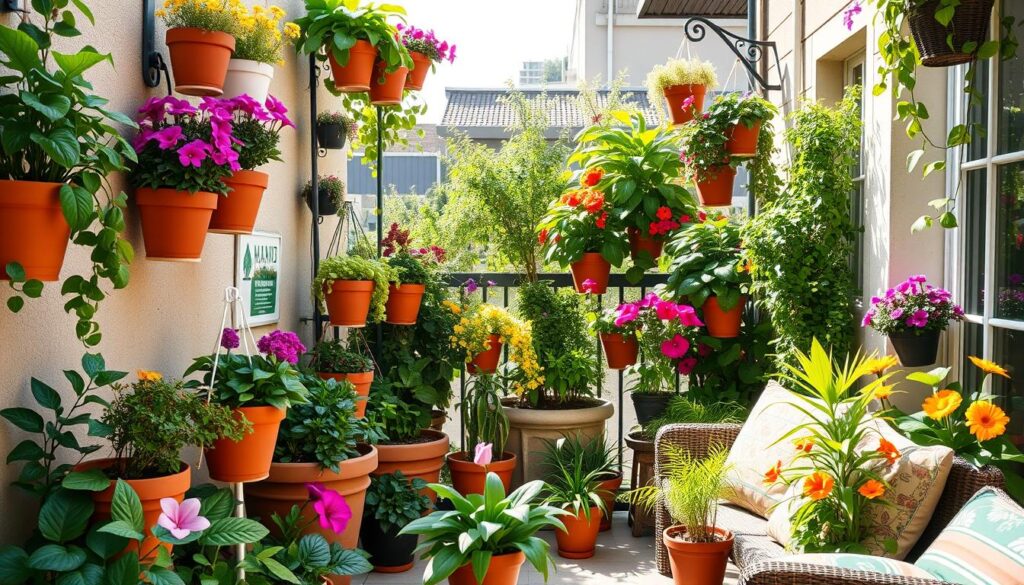
Space-Saving Planters
Space-saving planters maximize your balcony’s space. They come in various shapes and materials. Think about your plants’ needs, like drainage and sunlight.
Using container gardening, vertical gardening, and space-saving planters makes your balcony beautiful and functional. These solutions are great for both new and experienced gardeners. They help you enjoy your balcony and the benefits of gardening.
Smart Watering and Drainage Systems
Proper watering systems are key for balcony garden care. Too much water can cause soil to be waterlogged and rot the roots. Too little water can make plants wither and die. To solve these problems, use self-watering containers or drip irrigation systems. These systems water the roots directly, cutting down on evaporation and runoff.
Drainage systems are also important to keep water out of the soil. A good drainage system moves excess water away from plants. This prevents root rot and other issues. You can use gravel or sand at the bottom of containers for better drainage or install a French drain to move water away.
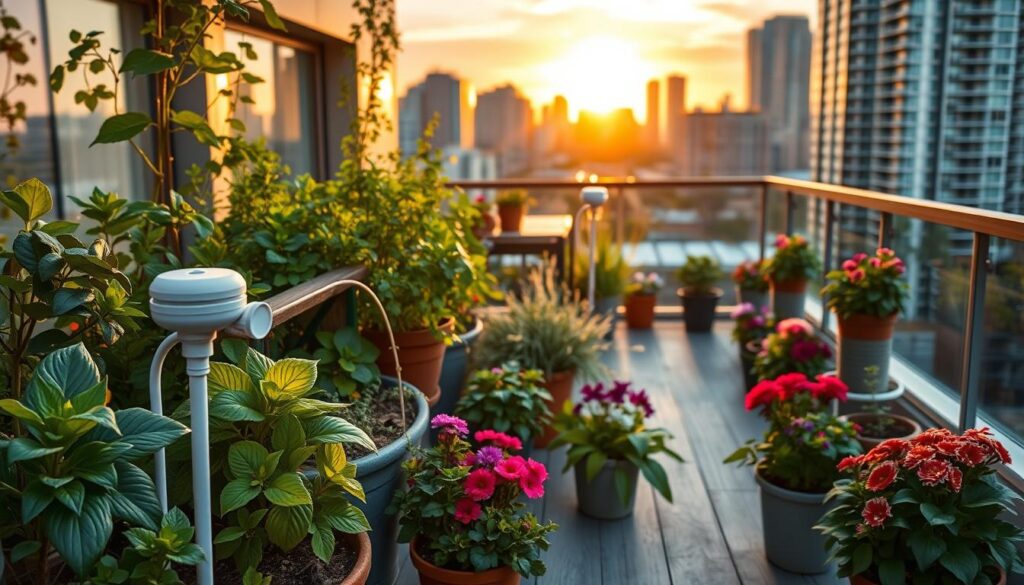
It’s also important to make a watering schedule. Check the soil moisture and adjust how often you water. Some plants need more water, while others prefer drier soil. Knowing what each plant needs helps you create a watering plan that works for them.
- Use self-watering containers or drip irrigation systems to deliver water directly to the roots of the plants
- Implement a drainage system, such as a layer of gravel or sand, to prevent waterlogged soil
- Monitor soil moisture and adjust the watering frequency accordingly
- Create a tailored watering schedule that meets the specific needs of each plant
By using smart watering and drainage systems, your balcony garden will get the right amount of water. This reduces the chance of overwatering and underwatering. It helps plants grow well and avoids common problems caused by bad watering and drainage.
| Watering System | Benefits |
|---|---|
| Self-watering containers | Reduced evaporation, improved soil moisture |
| Drip irrigation systems | Targeted watering, reduced runoff |
| Drainage systems | Prevention of waterlogged soil, root rot |
Maximizing Your Balcony Garden’s Potential
To make your balcony garden thrive, think about its unique space and limits. Use multi-level planting to use every inch and add beauty. This means layering plants of different heights and textures for a lively display.
Companion planting boosts your garden’s health. Choose plants that help each other grow, fight pests, and diseases. For instance, marigolds keep nematodes away from tomatoes, while basil and mint make herbs taste better.
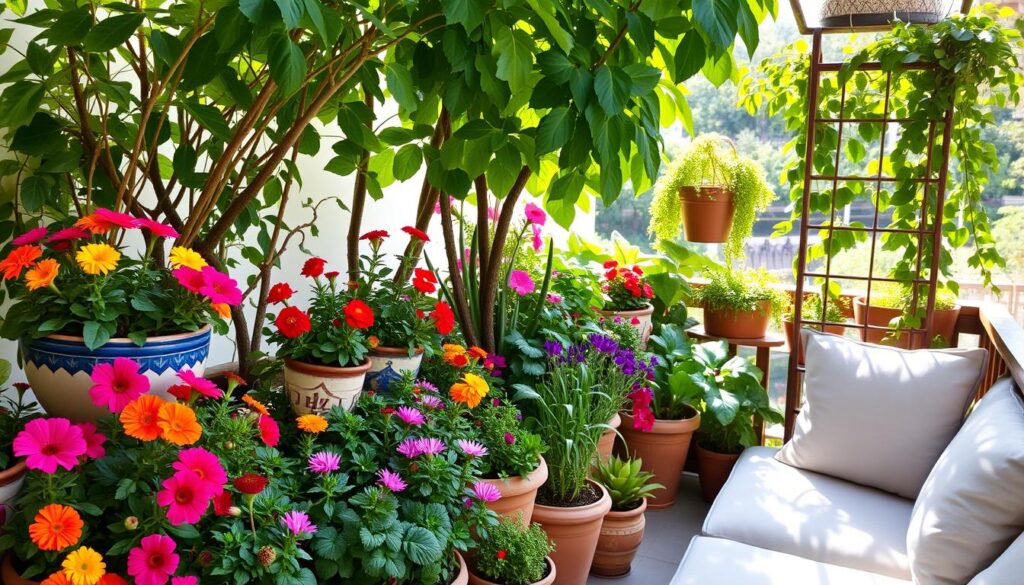
- Tomatoes, basil, and chives for a classic Mediterranean mix
- Cucumbers, dill, and mint for a refreshing and fragrant mix
- Carrots, sage, and radishes for a colorful and nutritious set
By using these ideas, you can make a stunning balcony garden. It will show off your creativity and care. Whether you’re new to gardening or experienced, these tips will help you enjoy a fruitful harvest.
| Plant Combination | Benefits |
|---|---|
| Tomatoes, basil, and chives | Improved flavor, reduced pests |
| Cucumbers, dill, and mint | Increased fragrance, improved growth |
| Carrots, sage, and radishes | Enhanced nutrition, reduced diseases |
Year-Round Maintenance Tips
To keep your balcony garden thriving, regular balcony garden maintenance is key. This means adjusting watering and fertilizing based on the season. For instance, plants need more water and food in spring and summer. But in fall and winter, they need less.
Watching out for pests and diseases is also vital in urban gardens. Pests like aphids, whiteflies, and spider mites can harm your plants. Use natural pest control, like introducing beneficial insects or neem oil, to keep them away.
Seasonal Care Guidelines
- Spring: Prune plants to encourage new growth, and fertilize with a balanced fertilizer.
- Summer: Water plants often, and support tall plants or vines.
- Fall: Water and fertilize less, and prune plants for winter.
- Winter: Protect plants from cold and wind, and water sparingly.
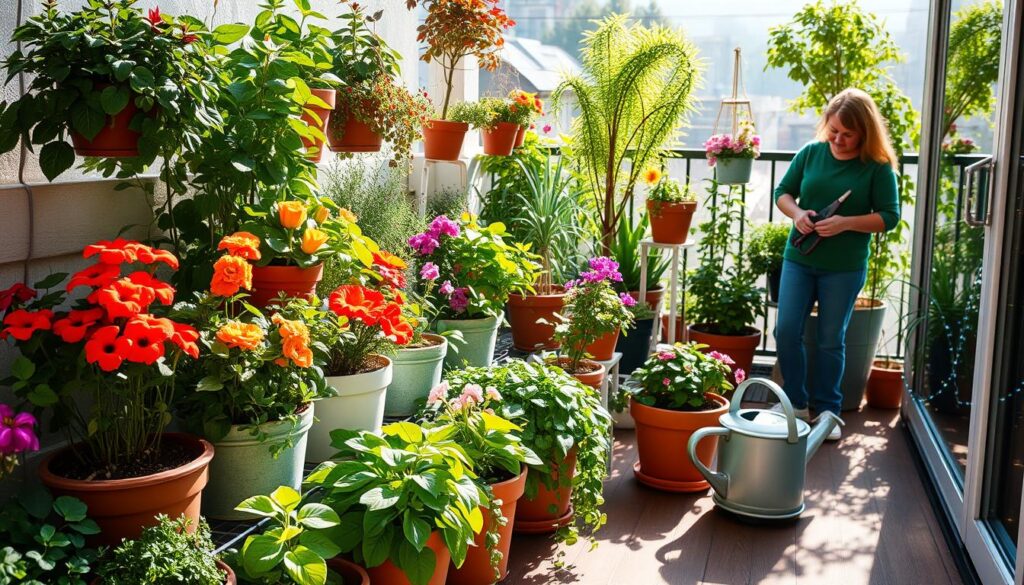
Pest Management in Urban Settings
Check your plants often for pests or diseases. Act quickly to stop infestations. Use physical barriers, like fine-mesh screens, to keep flying pests away.
| Pest | Signs of Infestation | Control Methods |
|---|---|---|
| Aphids | Curled or distorted leaves, sticky substance on leaves | Introduce beneficial insects, such as ladybugs or lacewings |
| Whiteflies | Small, winged insects on leaves, yellowing or stunted growth | Use yellow sticky traps, introduce beneficial insects |
| Spider mites | Fine webbing on leaves, yellowing or bronzing of leaves | Use neem oil, introduce beneficial insects |
Common Challenges in Balcony Gardening
Balcony gardening is rewarding but comes with challenges. One big issue is the lack of space. It’s hard to grow a garden with little room. But, using small containers and creative solutions can help you create a beautiful garden.
Another problem is limited sunlight. This makes it tough to grow some plants. Yet, you can use mirrors to reflect sunlight or pick plants that don’t need much sun. Common problems like high winds can be solved with windbreaks or heavy planters.
Some balcony gardening challenges and their solutions include:
- Lack of space: use space-saving containers or vertical gardening systems
- Limited sunlight: use mirrors or choose shade-tolerant plants
- High winds: use windbreaks or weighted planters
Understanding common problems and using creative solutions can help you grow a strong garden. Pick plants that fit your balcony’s conditions. Don’t be afraid to try new things. With patience and practice, you can beat any balcony gardening challenges and enjoy a beautiful garden.
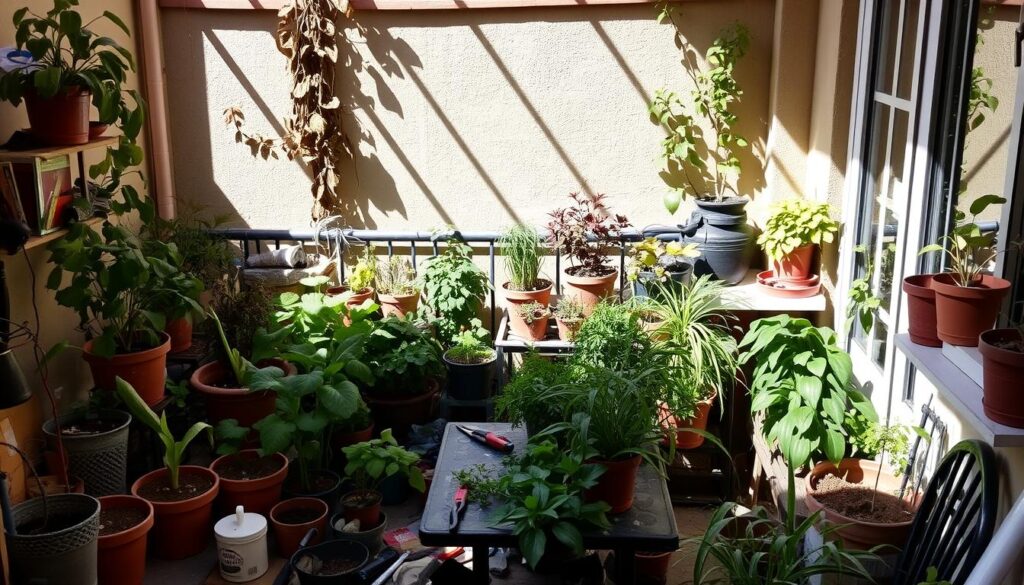
By providing the right conditions and using solutions to common problems, you can create a thriving balcony garden that brings joy and freshness to your outdoor space.
| Challenge | Solution |
|---|---|
| Lack of space | Use space-saving containers or vertical gardening systems |
| Limited sunlight | Use mirrors or choose shade-tolerant plants |
| High winds | Use windbreaks or weighted planters |
Conclusion: Creating Your Perfect Urban Oasis
Starting your balcony garden journey is exciting. It’s as rewarding as seeing your garden grow. Be patient, creative, and open to new ideas. This will help you turn your outdoor space into a lush oasis.
Whether you’re new to gardening or have experience, growing your own plants is incredibly fulfilling. Share your garden’s ups and downs with others. This way, we can all help make our cities greener, one balcony at a time.
Let your creativity shine and make your balcony a peaceful retreat. Enjoy watching your garden flourish. Let it become a place that refreshes your mind and body.
FAQ
What are the key considerations when starting a balcony garden?
Starting a balcony garden requires a few key steps. First, check how much space and sunlight you have. Then, know the weight limits of your balcony. Lastly, get the right tools and materials like containers, soil, and gardening tools.
What are some essential design principles for small balcony gardens?
Designing a small balcony garden is all about scale and texture. Use vertical elements and layering to make the space look good. Adding focal points can also enhance the look and feel of your garden.
How do I choose the right plants for my balcony garden?
Choosing the right plants is crucial. Think about how much sunlight they need and if they can handle shade. Also, pick plants that are in season and consider growing edible ones. Make sure they fit your climate and balcony conditions.
What are some creative container solutions for balcony gardens?
There are many creative ways to use containers in balcony gardens. Try vertical gardening systems, hanging baskets, and space-saving planters. These can help you make the most of your space and add a personal touch to your garden.
How do I maintain a healthy balcony garden year-round?
To keep your balcony garden healthy all year, follow seasonal care tips. Manage pests and prune your plants regularly. Using smart watering and drainage systems is also key to keeping your garden thriving.
What are some common challenges in balcony gardening, and how can I overcome them?
Common balcony gardening challenges include limited space and not enough sunlight. To tackle these, use containers that save space and mirrors to reflect light. Windbreaks can also protect your plants from strong winds.